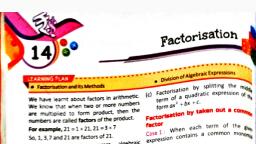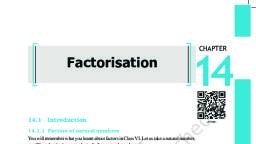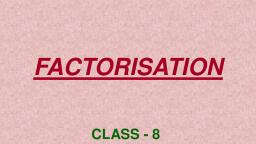Page 1 :
FACTORISATION, , 217, , CHAPTER, , Factorisation, , 14, , 14.1 Introduction, 14.1.1 Factors of natural numbers, You will remember what you learnt about factors in Class VI. Let us take a natural number,, say 30, and write it as a product of other natural numbers, say, 30 = 2 × 15, We know that 30 can also be written as, = 3 × 10 = 5 × 6, Thus, 1, 2, 3, 5, 6, 10, 15 and 30 are the factors of 30., Of these, 2, 3 and 5 are the prime factors of 30 (Why?), A number written as a product of prime factors is said to, be in the prime factor form; for example, 30 written as, 2 × 3 × 5 is in the prime factor form., , 30 = 1 × 30, Thus, 1 and 30 are also factors of 30., You will notice that 1 is a factor of any, number. For example, 101 = 1 × 101., However, when we write a number as a, product of factors, we shall not write 1 as, a factor, unless it is specially required., , The prime factor form of 70 is 2 × 5 × 7., The prime factor form of 90 is 2 × 3 × 3 × 5, and so on., Similarly, we can express algebraic expressions as products of their factors. This is, what we shall learn to do in this chapter., 14.1.2 Factors of algebraic expressions, We have seen in Class VII that in algebraic expressions, terms are formed as products of, factors. For example, in the algebraic expression 5xy + 3x the term 5xy has been formed, by the factors 5, x and y, i.e.,, 5xy = 5 × x × y, Note 1 is a factor of 5xy, since, Observe that the factors 5, x and y of 5xy cannot further, 5xy = 1 × 5 × x × y, be expressed as a product of factors. We may say that 5,, In fact, 1 is a factor of every term. As, x and y are ‘prime’ factors of 5xy. In algebraic expressions,, in the case of natural numbers, unless, we use the word ‘irreducible’ in place of ‘prime’. We say that, it is specially required, we do not show, 1 as a separate factor of any term., 5 × x × y is the irreducible form of 5xy. Note 5 × (xy) is not, an irreducible form of 5xy, since the factor xy can be further, expressed as a product of x and y, i.e., xy = x × y., , 2021–22
Page 2 :
218, , MATHEMATICS, , Next consider the expression 3x (x + 2). It can be written as a product of factors., 3, x and (x + 2), 3x(x + 2) = 3 × x × ( x + 2 ), The factors 3, x and (x +2) are irreducible factors of 3x (x + 2)., Similarly, the expression 10x (x + 2) (y + 3) is expressed in its irreducible factor form, as 10x (x + 2) (y + 3) = 2 × 5 × x × ( x + 2) × ( y + 3) ., , 14.2 What is Factorisation?, When we factorise an algebraic expression, we write it as a product of factors. These, factors may be numbers, algebraic variables or algebraic expressions., Expressions like 3xy, 5 x 2 y , 2x (y + 2), 5 (y + 1) (x + 2) are already in factor form., Their factors can be just read off from them, as we already know., On the other hand consider expressions like 2x + 4, 3x + 3y, x2 + 5x, x2 + 5x + 6., It is not obvious what their factors are. We need to develop systematic methods to factorise, these expressions, i.e., to find their factors. This is what we shall do now., 14.2.1 Method of common factors, , •, , We begin with a simple example: Factorise 2x + 4., We shall write each term as a product of irreducible factors;, 2x = 2 × x, 4=2×2, Hence, 2x + 4 = (2 × x) + (2 × 2), Notice that factor 2 is common to both the terms., Observe, by distributive law, 2 × (x + 2) = (2 × x) + (2 × 2), Therefore, we can write, 2x + 4 = 2 × (x + 2) = 2 (x + 2), Thus, the expression 2x + 4 is the same as 2 (x + 2). Now we can read off its factors:, they are 2 and (x + 2). These factors are irreducible., Next, factorise 5xy + 10x., The irreducible factor forms of 5xy and 10x are respectively,, 5xy = 5 × x × y, 10x = 2 × 5 × x, Observe that the two terms have 5 and x as common factors. Now,, 5xy + 10x = (5 × x × y) + (5 × x × 2), = (5x × y) + (5x × 2), We combine the two terms using the distributive law,, (5x× y) + (5x× 2) = 5x × ( y + 2), Therefore, 5xy + 10x = 5 x (y + 2). (This is the desired factor form.), 2021–22
Page 3 :
FACTORISATION, , 219, , Example 1: Factorise 12a2b + 15ab2, 12a2b = 2 × 2 × 3 × a × a × b, 15ab2 = 3 × 5 × a × b × b, The two terms have 3, a and b as common factors., Therefore,, 12a2b + 15ab2 = (3 × a × b × 2 × 2 × a) + (3 × a × b × 5 × b), = 3 × a × b × [(2 × 2 × a) + (5 × b)], (combining the terms), = 3ab × (4a + 5b), = 3ab (4a + 5b), (required factor form), , Solution: We have, , Example 2: Factorise 10x2 – 18x3 + 14x4, Solution:, 10x2 = 2 × 5 × x × x, 18x3 = 2 × 3 × 3 × x × x × x, 14x4 = 2 × 7 × x × x × x × x, The common factors of the three terms are 2, x and x., Therefore, 10x2 – 18x3 + 14x4 = (2 × x × x × 5) – (2 × x × x × 3 × 3 × x), + (2 × x × x × 7 × x × x), = 2 × x × x ×[(5 – (3 × 3 × x) + (7 × x × x)] (combining the three terms), = 2x2 × (5 – 9x + 7x2) = 2 x 2 (7 x 2 − 9 x + 5), ���, �����, �, , TRY THESE, Factorise:, , (i) 12x + 36, , (ii) 22y – 33z (iii) 14pq + 35pqr, , Do you notice that the factor, form of an expression has only, one term?, , 14.2.2 Factorisation by regrouping terms, Look at the expression 2xy + 2y + 3x + 3. You will notice that the first two terms have, common factors 2 and y and the last two terms have a common factor 3. But there is no, single factor common to all the terms. How shall we proceed?, Let us write (2xy + 2y) in the factor form:, 2xy + 2y = (2 × x × y) + (2 × y), = (2 × y × x) + (2 × y × 1), Note, we need to, = (2y × x) + (2y × 1) = 2y (x + 1), show1 as a factor, Similarly,, 3x + 3 = (3 × x) + (3 × 1), here. Why?, = 3 × (x + 1) = 3 ( x + 1), Hence,, 2xy + 2y + 3x + 3 = 2y (x + 1) + 3 (x +1), Observe, now we have a common factor (x + 1) in both the terms on the right hand, side. Combining the two terms,, 2xy + 2y + 3x + 3 = 2y (x + 1) + 3 (x + 1) = (x + 1) (2y + 3), The expression 2xy + 2y + 3x + 3 is now in the form of a product of factors. Its, factors are (x + 1) and (2y + 3). Note, these factors are irreducible., , 2021–22
Page 5 :
FACTORISATION, , (iii) ax + bx – ay – by, (v) z – 7 + 7 x y – x y z, , 221, , (iv) 15 pq + 15 + 9q + 25p, , 14.2.3 Factorisation using identities, We know that, (a + b)2 = a2 + 2ab + b2, (I), 2, 2, 2, (a – b) = a – 2ab + b, (II), 2, 2, (a + b) (a – b) = a – b, (III), The following solved examples illustrate how to use these identities for factorisation. What, we do is to observe the given expression. If it has a form that fits the right hand side of one, of the identities, then the expression corresponding to the left hand side of the identity, gives the desired factorisation., Example 4: Factorise x2 + 8x + 16, Solution: Observe the expression; it has three terms. Therefore, it does not fit, Identity III. Also, it’s first and third terms are perfect squares with a positive sign before, the middle term. So, it is of the form a2 + 2ab + b2 where a = x and b = 4, such that, a2 + 2ab + b2 = x2 + 2 (x) (4) + 42, Observe here the given, = x2 + 8x + 16, expression is of the form, a2 – 2ab + b2., Since, a2 + 2ab + b2 = (a + b)2,, Where a = 2y, and b = 3, by comparison x2 + 8x + 16 = ( x + 4)2 (the required factorisation), with 2ab = 2 × 2y × 3 = 12y., Example 5: Factorise 4y2 – 12y + 9, Solution: Observe 4y2 = (2y)2, 9 = 32 and 12y = 2 × 3 × (2y), Therefore,, 4y2 – 12y + 9 = (2y)2 – 2 × 3 × (2y) + (3)2, = ( 2y – 3)2, (required factorisation), Example 6: Factorise 49p2 – 36, Solution: There are two terms; both are squares and the second is negative. The, expression is of the form (a2 – b2). Identity III is applicable here;, 49p2 – 36 = (7p)2 – ( 6 )2, = (7p – 6 ) ( 7p + 6) (required factorisation), Example 7: Factorise a2 – 2ab + b2 – c2, Solution: The first three terms of the given expression form (a – b)2. The fourth term, is a square. So the expression can be reduced to a difference of two squares., Thus,, a2 – 2ab + b2 – c2 = (a – b)2– c2, (Applying Identity II), = [(a – b) – c) ((a – b) + c)], = (a – b – c) (a – b + c), , (Applying Identity III), (required factorisation), , Notice, how we applied two identities one after the other to obtain the required factorisation., Example 8: Factorise m4 – 256, Solution: We note, , m4 = (m2)2 and 256 = (16) 2, , 2021–22
Page 6 :
222, , MATHEMATICS, , Thus, the given expression fits Identity III., m4 – 256 = (m2)2 – (16) 2, = (m2 –16) (m2 +16) [(using Identity (III)], 2, Now, (m + 16) cannot be factorised further, but (m2 –16) is factorisable again as per, Identity III., m2–16 = m2 – 42, = (m – 4) (m + 4), 4, Therefore,, m – 256 = (m – 4) (m + 4) (m2 +16), , Therefore,, , 14.2.4 Factors of the form ( x + a) ( x + b), Let us now discuss how we can factorise expressions in one variable, like x2 + 5x + 6,, y2 – 7y + 12, z2 – 4z – 12, 3m2 + 9m + 6, etc. Observe that these expressions are not, of the type (a + b) 2 or (a – b) 2, i.e., they are not perfect squares. For example, in, x2 + 5x + 6, the term 6 is not a perfect square. These expressions obviously also do not, fit the type (a2 – b2) either., They, however, seem to be of the type x2 + (a + b) x + a b. We may therefore, try to, use Identity IV studied in the last chapter to factorise these expressions:, (x + a) (x + b) = x2 + (a + b) x + ab, (IV), For that we have to look at the coefficients of x and the constant term. Let us see how, it is done in the following example., Example 9: Factorise x2 + 5x + 6, Solution: If we compare the R.H.S. of Identity (IV) with x2 + 5x + 6, we find ab = 6,, and a + b = 5. From this, we must obtain a and b. The factors then will be, (x + a) and (x + b)., If a b = 6, it means that a and b are factors of 6. Let us try a = 6, b = 1. For these, values a + b = 7, and not 5, So this choice is not right., Let us try a = 2, b = 3. For this a + b = 5 exactly as required., The factorised form of this given expression is then (x +2) (x + 3)., In general, for factorising an algebraic expression of the type x2 + px + q, we find two, factors a and b of q (i.e., the constant term) such that, , ab = q and, Then, the expression becomes, or, or, or, , a+b=p, , 2, , x + (a + b) x + ab, x2 + ax + bx + ab, x(x + a) + b(x + a), (x + a) (x + b), which are the required factors., , Example 10: Find the factors of y2 –7y +12., Solution: We note 12 = 3 × 4 and 3 + 4 = 7. Therefore,, y2 – 7y+ 12 = y2 – 3y – 4y + 12, = y (y –3) – 4 (y –3) = (y –3) (y – 4), , 2021–22
Page 12 :
228, , MATHEMATICS, , (b) (2x)2 = 2x2, Make sure,, before, applying any, formula,, whether the, formula is, really, applicable., , (2x)2 = 4x2, , (c) (2a – 3) (a + 2), = 2a2 – 6, , Remember, when you, square a monomial, the, numerical coefficient and, each factor has to be, squared., , (2a – 3) (a + 2), = 2a2 + a – 6, , (d) (x + 8)2 = x2 + 64, , (x + 8)2, = x2 + 16x + 64, (e) (x – 5)2 = x2 – 25, (x – 5)2 = x2 – 10x + 25, Is the multiplication done by both Namrata and Salma correct? Give reasons for your, answer., Task 4, , While dividing a, polynomial by a, monomial, we divide, each term of the, polynomial in the, numerator by the, monomial in the, denominator., , Joseph does a division as :, , a+5, = a +1, 5, , His friend Sirish has done the same division as:, And his other friend Suman does it this way:, , a+5, =a, 5, , a+5 a, = +1, 5, 5, , Who has done the division correctly? Who has done incorrectly? Why?, , Some fun!, Atul always thinks differently. He asks Sumathi teacher, “If what you say is true, then, 64 4, = = 4?’’ The teacher explains, “ This is so, why do I get the right answer for, 16 1, 64 16 × 4 4, because 64 happens to be 16 × 4; 16 = 16 ×1 = 1 . In reality, we cancel a factor of 16, and not 6, as you can see. In fact, 6 is not a factor of either 64 or of 16.” The teacher, 664 4 6664 4, = ,, = , and so on”. Isn’t that interesting? Can you, adds further, “Also,, 166 1 1666 1, 64, help Atul to find some other examples like, ?, 16, , EXERCISE 14.4, Find and correct the errors in the following mathematical statements., 1. 4(x – 5) = 4x – 5, , 2. x(3x + 2) = 3x2 + 2 3. 2x + 3y = 5xy, , 4. x + 2x + 3x = 5x, , 5. 5y + 2y + y – 7y = 0 6. 3x + 2x = 5x2, , 7. (2x)2 + 4(2x) + 7 = 2x2 + 8x + 7, 9. (3x + 2)2 = 3x2 + 6x + 4, , 2021–22, , 8. (2x)2 + 5x = 4x + 5x = 9x
Page 13 :
FACTORISATION, , 229, , 10. Substituting x = – 3 in, (a) x2 + 5x + 4 gives (– 3)2 + 5 (– 3) + 4 = 9 + 2 + 4 = 15, (b) x2 – 5x + 4 gives (– 3)2 – 5 ( – 3) + 4 = 9 – 15 + 4 = – 2, (c) x2 + 5x gives (– 3)2 + 5 (–3) = – 9 – 15 = – 24, 11. (y – 3)2 = y2 – 9, 12. (z + 5)2 = z2 + 25, 14. (a + 4) (a + 2) = a2 + 8, 13. (2a + 3b) (a – b) = 2a2 – 3b2, 3x 2, =0, 15. (a – 4) (a – 2) = a2 – 8, 16., 3x 2, 3x, 1, 3, 1, 3x 2 + 1, =, =, =, 1, +, 1, =, 2, 17., 18., 19., 3x + 2 2, 4x + 3 4x, 3x2, 20., , 4x + 5, =5, 4x, , 21., , 7x + 5, = 7x, 5, , WHAT HAVE WE DISCUSSED?, 1. When we factorise an expression, we write it as a product of factors. These factors may be, numbers, algebraic variables or algebraic expressions., 2. An irreducible factor is a factor which cannot be expressed further as a product of factors., 3. A systematic way of factorising an expression is the common factor method. It consists of three, steps: (i) Write each term of the expression as a product of irreducible factors (ii) Look for and, separate the common factors and (iii) Combine the remaining factors in each term in accordance, with the distributive law., 4. Sometimes, all the terms in a given expression do not have a common factor; but the terms can be, grouped in such a way that all the terms in each group have a common factor. When we do this,, there emerges a common factor across all the groups leading to the required factorisation of the, expression. This is the method of regrouping., 5. In factorisation by regrouping, we should remember that any regrouping (i.e., rearrangement) of, the terms in the given expression may not lead to factorisation. We must observe the expression, and come out with the desired regrouping by trial and error., 6. A number of expressions to be factorised are of the form or can be put into the form : a2 + 2 ab + b2,, a2 – 2ab + b2, a2 – b2 and x2 + (a + b) + ab. These expressions can be easily factorised using, Identities I, II, III and IV, given in Chapter 9,, a2 + 2 ab + b2 = (a + b)2, a2 – 2ab + b2 = (a – b)2, a2 – b2 = (a + b) (a – b), x2 + (a + b) x + ab = (x + a) (x + b), 7. In expressions which have factors of the type (x + a) (x + b), remember the numerical term gives ab. Its, factors, a and b, should be so chosen that their sum, with signs taken care of, is the coefficient of x., 8. We know that in the case of numbers, division is the inverse of multiplication. This idea is applicable, also to the division of algebraic expressions., , 2021–22
Page 14 :
230, , MATHEMATICS, , 9. In the case of division of a polynomial by a monomial, we may carry out the division either by, dividing each term of the polynomial by the monomial or by the common factor method., 10. In the case of division of a polynomial by a polynomial, we cannot proceed by dividing each term, in the dividend polynomial by the divisor polynomial. Instead, we factorise both the polynomials, and cancel their common factors., 11. In the case of divisions of algebraic expressions that we studied in this chapter, we have, Dividend = Divisor × Quotient., In general, however, the relation is, Dividend = Divisor × Quotient + Remainder, Thus, we have considered in the present chapter only those divisions in which the remainder, is zero., 12. There are many errors students commonly make when solving algebra exercises. You should avoid, making such errors., , 2021–22



































































